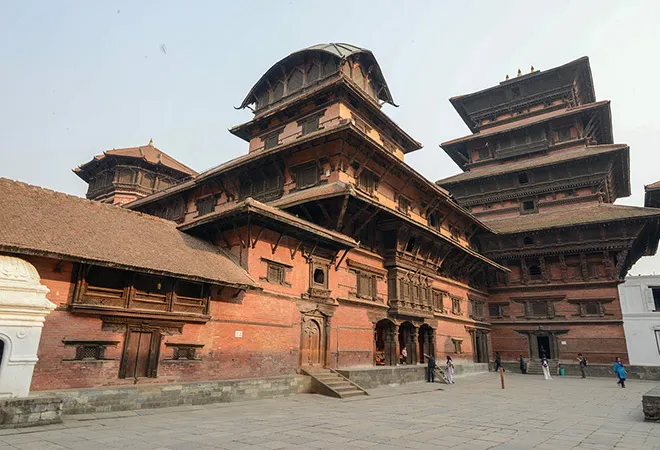
In Nepal, the Indian currency is not a legal tender for financial transactions. Yet, in practice, it is widely accepted in each part of the country – be it in the Terai, hills or the mountain regions. The Indian currency is next to Nepali rupee in the country in terms of circulation and its acceptability and it forms one-fifth of Nepal’s total monetary transactions.<1>
The Indian currency is widely in circulation because the working population from Nepal brings with them huge amount of Indian notes from India in the form of remittances. Especially in the bordering Terai region of the country, the Indian currency is more in use as compared to the Nepali rupee for trade and other commercial transactions with India. The people of Terai have to visit India for buying or selling products across the Nepal-India border for which they use only Indian currency. In Chandani and Dodhara VDCs in Mahakali zone, for example, people use mostly Indian currency for financial transactions. Over 95 per cent of the transactions in the region take place in Indian currency alone. <2> So is the case in many other parts of Nepal-India border.
In view of the interdependence of Nepalese and Indian people in the border region, the announcement made by Indian Prime Minister Narendra Modi on November 8, 2016 to demonetise the high value banknotes of Rs. 500 and Rs. 1000 denominations made its immediate impact on the Nepalese economy.
Indian currency in Nepal
Significantly, the Indian notes of Rs. 500 and Rs. 1000 denominations were banned in Nepal until 2014 at the request of India. This was on account of the growing problem of counterfeit notes from Nepal to India. The ban was withdrawn in August 2015 and this allowed people, coming from India to Nepal, to carry with them Indian notes of Rs. 500 and Rs. 1000 denominations up to Rs. 25,000.
However, there is no information about the extent to which the traders, migrant workers’ families, border inhabitants and the general people hold Indian currency of these higher denominations in Nepal. It is speculated that some Nepalese have with them these notes worth billions of rupees.<3>
Reports say that certain Indian companies/individuals, who got panicky after the demonetisation announcement, rushed to Nepal with the banned notes and got them exchanged into Nepalese rupees either at certain Nepalese commercial banks or at the unauthorised units. Despite the official exchange rate of Indian Rs. 100 equivalent to Nepalese Rs. 160, such big houses/individuals even exchanged Indian Rs. 100 for just Nepalese Rs. 100.<4>
It is believed that the Nepalese financial institutions, including the banks, have far more reserve of banned Indian notes than what they have declared. Officially, the Nepal Rastra Bank, the central bank of the country, has declared that Nepal has Indian notes of Rs. 500 and Rs. 1000 worth 33.6 million in the banking channels.<5> But Pashupati Murarka, the chief of the Federation of Nepalese Chambers of Commerce and Industry (FNCCI), estimated that the individuals and informal sectors in Nepal had with them banned Indian Rs. 500 and Rs. 1000 notes worth Rs. 10 billion.<6>
Meeting new challenge
Immediately after the notes ban in India, the financial institutions in Nepal, including the Nepal Rastra Bank and the commercial banks, stopped exchanging banned Indian notes. It still continues even with the new Indian notes of Rs. 500 and Rs. 2000, with the Nepal Rastra Bank saying these new Indian notes are “unauthorised and illegal.”<7> The new notes are expected to become legal only after getting the Foreign Exchange Management Act (FEMA) notification from India.<8> It is, however, not known if Nepal has received any such FEMA notification from India.
In an important development, the Nepal Rastra Bank also lowered the limit of exchange of Indian banknotes in Nepal. A provision was made whereby a person could exchange Nepalese rupees into Indian rupees up to 2,000 rupees by producing citizenship certificate to the bank. On producing copies of air or train ticket to travel to India, a person could exchange Nepalese rupees into Indian rupees up to 10,000. And, on medical ground, for treatment in India, a person is entitled to exchange up to 25,000 Indian rupees.<9> But in actual practice, the common people could hardly benefit much from such arrangement.

Supply of Indian currency
Because of India’s growing clout in the international market, the Indian currency is in huge demand in many countries of the world. Significantly, the Indian currency is more in circulation in Nepal and Bhutan than in other country of the world. However, over last few years, the central bank, commercial banks and other financial institutions in the country have failed to meet the demand for the Indian currencies. This is one of the reasons why one has to pay far more than the official exchange rate while buying Indian rupees against the Nepalese rupees.
Shortage of Indian currency is not a new phenomenon in Nepal. For so many years, the people in general and those in Terai in particular have been experiencing severe crunch of Indian currency. The Nepal Rastra Bank and the commercial banks have not been able to supply enough Indian currency as per their needs. Demonetisation further aggravated the situation. Never before in Nepal was so much of shortage of Indian currency as it happened thereafter.
People who need Indian currency mostly have no option but to approach the unauthorised units in the black market, which charge exorbitant rates, to get Indian currency. And due to the growing demand for Indian currency, the Nepalese currency is devalued in the market, though unofficially. Officially, the value of Nepalese currency seems to be stable simply because the Nepalese currency is pegged to Indian currency. If free exchange rate were allowed in open market between Nepalese and Indian rupees, the value of the Nepalese rupees would sink further down.
At a time when Nepal experienced enormous shortage of Indian currency, the smuggling of gold through its territory to India helped a lot in meeting its requirement. For quite some time, the smuggling of gold from third country/countries through Nepal has been increasing on an enormous scale. Existing supply of gold in the Indian market does not meet the entire demand. Because of that, gold smuggling is rampant and of late Nepal has emerged as important transit country for the smuggling of gold to India. Many Indians pay in Indian currency to the Nepalese to buy gold in Nepalese market, which is one of the major sources of supply of Indian currency in the country.
Therefore, many of those who are involved in currency exchange buy Indian currency from the gold dealers at higher than the official exchange rate. Such Indian currency is mostly made available to the needy people at still higher rate. In fact, the situation could have reached panic level in Nepal if there were no such supply of Indian currency from the Nepalese gold dealers.
Relief to security agencies
The black cash in the Indian economy accounted for 9.2 per cent of the black economy, which is estimated at 25 per cent of the GDP.<10> Whether in black or white form, most of the money that remained idle returned to the banking channel. Nearly 97 per cent of the notes of higher denominations returned to the bank accounts.<11> It is likely that all such money would be invested in one or the other economic activities. This will not only raise income but will also generate employment opportunities in India.
It is not yet known how Nepal would be benefited from the notes ban in India. But it is widely believed that many of such elements who indulged in activities of supplying fake Indian currency from or through the route of Nepal into India turned to be bankrupt over night. This provided a great relief to the security agencies who faced enormous difficulties in controlling such activities.
Impact on the economy
In its recent report on Global Economic Prospects – Weak Investment in Uncertain Times, the World Bank noted that “Spillovers from India to Nepal and Bhutan, through trade and remittances channels, could negatively impact growth in India’s neighbourhood.”<12> Accordingly, it was found that trade and other commercial activities between Nepal and India were largely affected. Local share markets in the country also dropped by 27 points.<13>
Demonetisation badly affected the flow of tourists from India to Nepal. The Indian tourists, whose share in total tourist arrivals in the country is still quite high, bring with them huge amount of Indian currency. But their number fell drastically following this event. The tourism industry in Nepal that had started picking up after the earthquake of April 25, 2015 met big jolt due to the demonetisation of Indian notes.
The other sector that was hit badly by the demonetisation was the casino industry in Nepal. The Indian tourists largely stopped coming to Nepal to play at the casinos. This was due to the fact that they experienced liquidity crunch for not being able to withdraw required amount of money from ATMs or their accounts. The hotel occupancy rates were affected severely.<14>
There are 10 big casinos in Kathmandu, including Hotel Soaltee, Hotel Yak and Yeti, Hotel Hayat Regency and Hotel Sangrila. Besides, there is one mini casino in Kathmandu and four running along Nepal-India border. Nearly two thirds of the customers of the casinos are Indians. And in the mini casinos, 95 per cent of the customers are Indians.
Finding a mechanism
The notes ban in India affected people in all parts of the country. But those of the Nepalese who had access to India somehow managed to exchange banned notes into new ones. Yet, there are people who for one or the other reason failed to do so. Those who are affected most are the genuine people who failed to exchange banned notes into new ones within the stipulated time of December 30 last year.
Understanding the seriousness of the situation caused by the notes ban, the Nepali Prime Minister talked to his Indian counterpart, Narendra Modi, to develop a mechanism whereby the Nepalese possessing old Indian currency could exchange them into new Indian notes. News was also pouring that the Nepal Rastra Bank and the Reserve Bank of India were in dialogue on this issue. There were news of dialogue between the two countries at the level of finance ministries and diplomatic levels also. Besides all these, a committee was also formed between the two countries to resolve the crisis. But as yet, no mechanism could be developed to find a solution.
The Nepal Rastra Bank was expecting an Indian team to come to Nepal till February 22, 2017 to facilitate the exchange of banned Indian notes of Rs. 500 and Rs. 1000. But the team did not come.<15> Initially, the Nepal Rastra Bank proposed to India that a Nepalese could be allowed to exchange maximum up to Indian Rs. 25,000. Expectations are that the people in Nepal would be allowed to exchange the banned Indian notes within the given limit for some weeks if the Nepalese modality is accepted by India.
But in certain quarters it is feared that unscrupulous elements in India might bring to Nepal whatever banned notes they have and get them exchanged into new notes. This is also one of the factors why there is so much of delay in developing certain mechanism to exchange old notes into new ones in Nepal.
Nevertheless, certain groups of people are still hopeful in Nepal that some mechanism would be developed by the end of this month. But others are losing hope of any such solution. March end is still important for many of the people as it was announced immediately after the notes ban in India that those who would not be able to exchange the old notes of higher denominations into new ones would still be able to do so at the Reserve Bank of India’s offices if they could come out with sufficient justifications.
It is true that many Nepalese – be it in the hills, mountain or the Terai regions – have somehow or the other managed to exchange the old currency notes into new ones, using their access to India through their contacts or relations. However, there are still many in the country who have not been able to exchange the banned notes into new notes. They should not be punished. Some mechanism needs to be developed to address the issue urgently while not allowing any unscrupulous elements to bring black money and turn it into white money.
Dr. Hari Bansh Jha is the Executive Director of the Centre for Economic and Technical Studies, Kathmandu, Nepal
<1> IANS, “Nepal also hit as India bans its Rs. 500, Rs. 1000 notes,” The Economic Times, November 9, 2016 in http://economictimes.indiatimes.com/news/politics-and-nation/nepal-also-hit-as-india-bans-its-rs-500-rs-1000-notes/articleshow/55336526.cms
<2> Himalayan News Service, “High circulation of Indian currency in Chandani, Dodhara VDCs,” The Himalayan Times, February 18, 2017.
<3> IANS, No. 1.
<4> Based on interview with businessman in Kathmandu.
<5> Anil Giri, “Demonetization affects Nepal, black marketing of currency rampant at border,” Hindustan Times, November 21, 2016 in http://www.hindustantimes.com/world-news/rs-500-100-notes-being-illegally-exchanged-at-nepal-india-border/story-sMDe2sYgVnhozJphA6yVxM.html
<6> Gopal Sharma, “Nepali migrant workers unwitting victims of India cash crackdown,” REUTERS, November 24, 2016 in http://in.reuters.com/article/india-modi-corruption-nepal-idINKBN13J14Q
<7> PTI, “Nepal bans new Indian Rs. 500 and Rs. 2,000 notes,” The Indian Express, November 24, 2016 in http://indianexpress.com/article/india/india-news-india/nepal-bans-new-indian-demonetisation-rs-500-and-rs-2000-notes-4393536/
<8> IANS, “New Indian notes of Rs 500, 2,000 ‘illegal’ in Nepal for now,” The Economic Times, November 24, 2016 in http://economictimes.indiatimes.com/news/economy/policy/new-indian-notes-of-rs-500-2000-illegal-in-nepal-for-now/articleshow/55605314.cms
<9> IANS, “Reserve Bank of India to give Nepal rupees 1 billion in 100-rupee notes,” The Economic Times, January 7, 2017 in http://economictimes.indiatimes.com/news/economy/finance/reserve-bank-of-india-to-give-nepal-rupees-1-billion-in-100-rupee-notes/articleshow/56377356.cms
<10> Surjit Bhalla, “Black cash in India,” The Indian Express, December 6, 2016 in http://indianexpress.com/article/opinion/columns/demonetisation-black-money-india-economy-gdp-4412283/
<11> Siddhartha Singh and Bibhudatta Pradhan, “India Said to Get 97% Banned Notes is Setback to Graft Crackdown,” Bloomberg, January 4, 2017 in https://www.bloomberg.com/news/articles/2017-01-04/india-said-to-get-97-banned-notes-in-setback-to-graft-crackdown
<12> Himalayan News Service, “India’s demonetization could impact Nepal,” The Himalayan Times, January 12, 2017
<13> IANS, No. 1.
<14> Onlinekhabar, “Bharatiya Notbandile Thala Pare Nepalka Casino,” (Nepali), Onlinekhabar.com, January 27, 2017.
<15> Onlinekhabar, “Bharu Satahima Bharat Udasin, Toli Nai Pathayen,” (Nepali), Onlinekhabar.com, Kathmandu, Falgun 12, 2073 in http://www.onlinekhabar.com/2017/02/547140/
The views expressed above belong to the author(s). ORF research and analyses now available on Telegram! Click here to access our curated content — blogs, longforms and interviews.





 PREV
PREV


